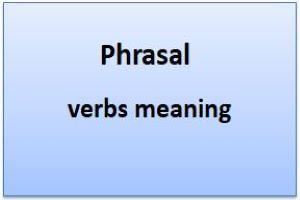Phrasal verbs definition and examples:
You probably utilize phrasal verbs, “an idiomatic phrase made up of a verb and a secondary element, usually an adverb,” daily and aren’t even aware of it. These types of verbs generally consist of two to three words, but phrasal verbs cannot be translated exactly word for word; you must learn them through examples and definitions. The verb or adverb takes on a different meaning each time it is added to the basic verb to make it a phrasal verb. As an example, “BACK UP.”.
If we take the literal meaning of back and up, they are indicating directions, but when we combine both of them to make a single phrasal verb, it will become “BACK UP.” The meaning of backup is “giving up,” and it can also be used as having “other plans.”. Depending on the situations in the sentences, these single phrasal verbs can be used for two different meanings. To understand them better, consider the examples below.
- You are failing now; do you have any backup plans?
- Why did you not try again? You must not back up at that time.
Phrasal verbs. They’re very common in spoken and informal English. They indicate action.
They’re made up of two parts: a verb and a preposition or adverb. For example, stand up or sit down.
In these phrasal verbs, the adverb or preposition comes directly after the verb. Occasionally, the preposition or adverb is placed after the object. For example, put your books away.
We can also say to put away your books. The placement of the object and preposition or adverb can normally be replaced unless we are using a pronoun for our object. For example, let’s use the pronoun them in place of the books. We say to put them away. We cannot say to put them away.
If using a pronoun as the object of a phrasal verb, it must go between the verb and a preposition or adverb.
The meaning of some phrasal verbs is more apparent. They’re literal. Standing together means to stand up. Put with away means to put away.
But many phrasal verbs are not literal. They’re figurative. The meaning of a phrasal verb can often be something completely different from the base verb. This means that phrasal verbs need to be memorized individually. Take this phrasal verb, “makeup.”. The verb make means to build or form something. You could make a pizza.
But when used in the phrasal verb “makeup,” the meaning is completely different. “Makeup” refers to people forgiving each other.
I wanted to “make up” with my friend after our fight.
A few more examples are:
- She brought up the same points as always.
- Ayra handed in the documents to the police.
- They make up stories when they lie.
- He pointed out my mistake.
Transitive and Intransitive Verbs:
Transitive and intransitive phrasal verbs in English can be divided into two main groups: transitive verbs and intransitive verbs.
Transitive Verb:
A transitive verb requires an object or something after it to complete the sentence. The object after a transitive verb would be a noun or a pronoun. Let’s add the noun dictionary. The sentence becomes I need a dictionary; at the moment, the sentence is complete and clear to understand. We added the object to the dictionary after the transitive verb. The order is subject plus transitive verb plus object. It is because transitive verbs need an object after them. The almost same meaning of transitive or intransitive verbs applies to phrasal verbs, which also require an object. If we say, “I’m looking for,” then you must say, Looking for what? Or looking for whom? Again, this sentence is incomplete because we need an object after this transitive verb. Let’s say that my keys are the object that I’m looking for. “I’m looking for my keys.”. Now the sentence is clear and makes sense. We needed to add an object after the transitive verb to make the sentence complete.
Intransitive verbs:
Intransitive verbs should not have a direct object after them. For example, I smiled here because we cannot have an object after the intransitive verb. Smile. You cannot smile at something. This is incorrect. The subject is taking action.
of the verb, and nothing receives the action. An intransitive verb could not proceed with the action on an object. An intransitive verb conveys an action that is complete in itself, and there is no need for an object to receive the action.
A few phrasal verbs would be both transitive and intransitive. For example, the phrasal verb takes off. Take-off would be transitive in one sentence and intransitive in another. A phrasal verb’s meaning usually changes based on whether it is transitive or intransitive. Look at the following example. If take-off is transitive, it means to remove something. If takeoff is intransitive, it means to depart from the ground and begin to fly. He took off his tie. When he got home, he took off. The past tense of takeoff is transitive, so it needs an object, in this case, his tie. Since there is an object after a takeoff, we know the meaning can be to remove something. Furthermore, he removed his tie when he got home.

